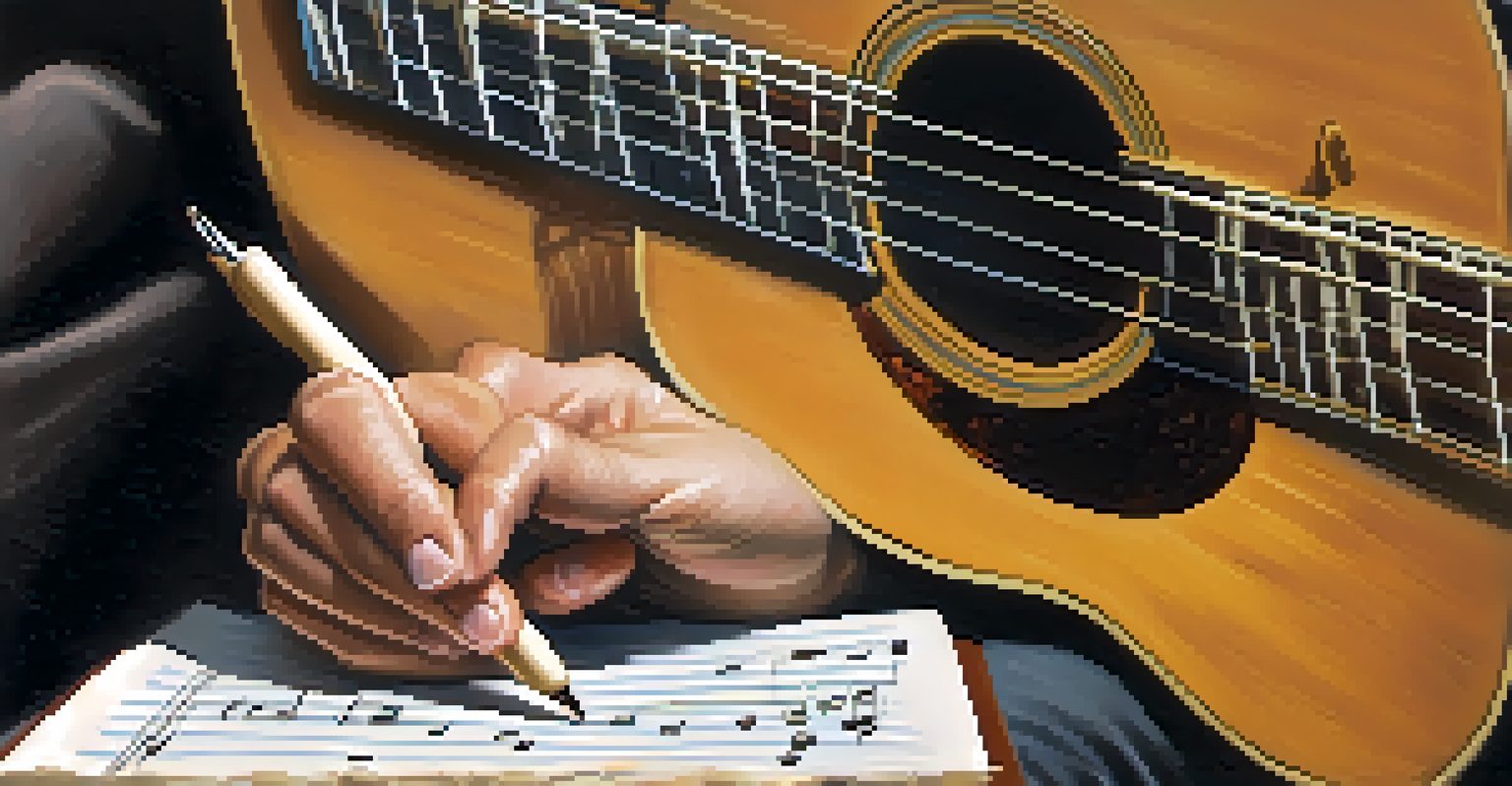Developing a Systematic Approach to Guitar Transcription

Understanding Guitar Transcription Basics
Guitar transcription involves converting music from audio to written notation. This process can help you understand the nuances of a piece, from melody to rhythm. By breaking down a song, you can identify chords, notes, and techniques used by the guitarist, making it easier to learn and replicate their style.
Transcription is the process of taking a piece of music and turning it into a written format, allowing musicians to learn and understand it more easily.
Many musicians shy away from transcription, believing it to be too complex or time-consuming. However, with a systematic approach, you can simplify the task. Think of it like piecing together a puzzle; each note and chord is a part that contributes to the whole picture of the song.
Embracing transcription not only enhances your listening skills but also deepens your musical knowledge. It’s an invaluable tool for any guitarist looking to expand their repertoire and improve their playing.
Setting Up Your Transcription Environment
Creating the right environment is crucial for effective transcription. Find a quiet space with minimal distractions where you can focus solely on the music. Having a comfortable chair and good lighting can make a world of difference in your concentration and productivity.

Additionally, having the right tools at your disposal can streamline your transcription process. Consider using software that allows you to slow down audio without changing the pitch, which can be incredibly helpful when deciphering fast licks or complex rhythms.
Mastering Guitar Transcription
Guitar transcription enhances your musical skills by breaking down songs into their core components, making them easier to learn.
Lastly, ensure you have a notebook or digital tool ready to jot down your findings. This organized approach will keep your thoughts clear and make it easier to refer back to your notes later.
Choosing the Right Music for Transcription
Selecting the right piece of music is essential for your transcription journey. Start with songs that are within your skill level; this will prevent frustration and keep you motivated. As you gain confidence, gradually introduce more complex pieces to challenge yourself.
The more you listen, the more you can understand the complexities of a piece, and the better you'll become at transcribing it.
Try to pick songs that resonate with you personally; this emotional connection can make the transcription process more enjoyable. You’re not just decoding notes; you’re engaging with music that inspires you, which can lead to a deeper understanding and appreciation.
Additionally, consider the genre and style of music you want to learn. Different genres often have unique techniques and rhythms, so diversifying your transcription choices can expand your skills and versatility as a guitarist.
Listening Techniques for Effective Transcription
Listening carefully is a key component of transcription. Start by breaking the song down into manageable sections, such as verses or choruses. Focus on one section at a time to avoid feeling overwhelmed and to maintain clarity in what you’re trying to transcribe.
It can be helpful to listen multiple times, each time focusing on different elements. For instance, on the first listen, concentrate on the melody; on the second, pay attention to the rhythm and timing. This layered listening approach helps you absorb the song's intricacies.
Create a Focused Workspace
A quiet and organized environment with the right tools can significantly improve your transcription efficiency and clarity.
Don't hesitate to use tools like looping sections of the audio to repeat challenging parts. This practice enables you to zero in on difficult passages and catch every nuance, making transcription much more manageable.
Transcribing Melodies and Chords
Once you've honed your listening skills, it’s time to start transcribing melodies and chords. Begin by identifying the root notes and then work your way through the melody. Using a keyboard or your guitar, play along to confirm you’re hitting the right notes.
For chords, try to determine the underlying harmony. Listen for changes in the bass line, as these often indicate chord shifts. Writing down chord progressions can be incredibly helpful in visualizing the structure of the song.
As you transcribe, don't be afraid to pause and rewind frequently. This iterative process is crucial for accuracy and will help you build a strong foundation for the rest of the song.
Documenting Your Transcription Work
Documenting your transcription is essential for future reference and practice. Whether you prefer handwritten notes or digital formats, make sure your transcriptions are clear and organized. This way, you can easily revisit your work and see your progress over time.
Consider using standard notation or tablature to record your findings. Tablature is particularly popular among guitarists as it visually represents the strings and frets, making it easier to follow along.
Effective Listening Techniques
Utilizing layered listening and looping sections helps you capture the nuances of a song, making the transcription process more manageable.
Regularly reviewing your transcriptions can also reinforce your learning. By going back to previously transcribed pieces, you’ll notice improvements in your playing and understanding of music theory.
Practicing with Your Transcriptions
Now that you have your transcriptions, it’s time to put them into practice. Start by playing slowly, ensuring you’re hitting the correct notes and rhythms. Gradually increase your speed as you become more comfortable with the piece, allowing muscle memory to develop.
Incorporate the transcribed pieces into your regular practice routine. This not only keeps your practice sessions fresh but also gives you the chance to apply new techniques and styles you've learned from the transcription process.

Consider playing along with the original track once you feel confident. This will help you develop your timing and phrasing, making it a fun way to enhance your playing and solidify what you've learned.